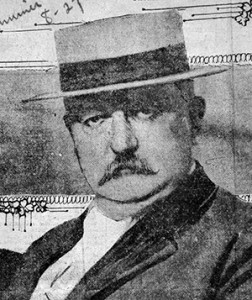
Patrick Calhoun, chief of United Railroads, had many reasons to be unhappy in May of 1907. His street carmen were on strike and he was about to be indicted for bribing San Francisco supervisors. Chronicle/SFHC/SFPL/SB
Members of IBEW 151 joined the Street Carmen in a new strike against United Railroads in 1907. The Street Carmen wanted the 8-hour day. IBEW 151 members were determined to help them get it. Company president Patrick Calhoun was determined that they wouldn’t. Once again he hired strikebreaker James Farley to import scabs.
Calhoun had grown up surrounded by slaves, the son of the largest cotton planter in the old South. Calhoun’s attitude toward workers’ rights hadn’t changed much since then. He was a whiz at corporate mergers and acquisitions. He bought up and consolidated railroads in the South. He assembled street railway systems and utility companies in Pittsburgh, PA. He amassed a fortune on Wall Street.
At the start of the 20th century, he put together United Railways in San Francisco and bribed virtually every member of the Board of Supervisors to approve his plan for an overhead trolley system. He was a businessman who was used to having things his own way. When the Street Carmen walked out on May 6, 1907, Calhoun terminated relations with the union “permanently and forever” and the next day ordered his army of scabs into action.